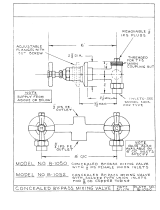
Speakman/SE-362 Installation
6 9-6-2011 Speakman Company • 215-1726 Rev. A; EN 11-09-005
Troubleshooting Thermostatic Mixing Valve
Problem Cause Solution
External leaks in the
system
Either the NPT joints or the o-rings have been
damaged.
Replace the NPT joints and/or o-rings where necessary. For
replacement of o-rings, contact your representative and ask for
O-Ring Seal Kit (S65-173).
No hot water flow (cold
water flow only)
The thermostat has failed and, subsequently, the
safety shut-off has engaged.
Inspect Thermostat:
1. Remove the top cap and pull out the push rod and thermostat.
2. Insert a 7/16" dia. rod into the thermostat bellows.
3. Mark the length of the thermostat bellows (at room temperature,
with 10 lb. of force, the bellows length should be approx. 1-3/16"—1-
1/2" ).
4. If the thermostat bellows length is not in the proper range, the
thermostat must be replaced (it cannot be repaired). Contact your
representative and ask for Thermostat Kit (S65-174).
Limitedwaterow The inlet shut-off valve may be partially closed
or there has been a significant decrease in water
pressure.
Dirt and debris have collected on the check
screen or seat, limiting the movement of the stop
and checks.
Clean Stop and check Valves:
Remove the stop and checks, clean the screen and seat and
reassemble the valve. Do not remove the seat. The components
may be scraped with a screwdriver to remove debris. A pair of
tweezers works well for pulling debris out from the seat. If the stop
and checks need to be replaced, contact your representative and
ask for Check/Stop Kit (S65-337).
Temperature fluctuation
or improper Temperature
The stop and check sections of the valve do not
move freely.
Clean Stop and Check Valves as described above.
Thermostat is slowly failing. Check Thermostat as described above, or replace.
Inlet supply line to the mixing valve is being
shared by other pieces of equipment that are
used only periodically, such as laundry appliances
or washdown stations. It may reduce the inlet
pressure to the mixing valve to less than 10 PSI.
The supply line size may not be large enough to
supply both the valve and the other appliances.
Enlarge the supply line size, reconfigure the supply line or regulate
the supply usage.
Recirculation is not balanced. Review recirculation set up on page 5.
Piston does not move freely and must be cleaned. See next page for piston disassembly and cleaning directions.
Before attempting to troubleshoot the valve or
disassemble the components, check for the following:
• Stop/check valves are fully open (the slotted stem
must be flush with the stop/check cap) and that all
inlet and outlet shut-off valves are open
• Hot and cold inlet pipes are connected properly,
and that there are no cross-connectio ns or leaking
stop/check valves
• Water heater output is at least 15° F above the set
temperature.
Be sure to close the appropriate shut-off valves prior
to disassembly of the valve and reopen the valves
after inspection and repair is complete.
Stop/Check Valve
Valve Seat
Stop/Check
Strainer










